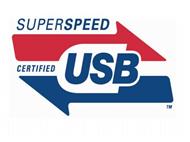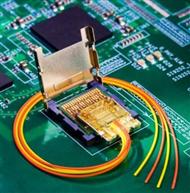After the USB 3.0 specification was finalized, it was claimed that the transmission bandwidth would be raised to 5GBit/sec. The specification target is getting closer and closer. Observing the development of the USB interface, there has been no major upgrade for nearly 10 years, especially the specification has only changed significantly recently. In the trend of promoting USB 3.0 applications, not only terminal product manufacturers are keen to participate, but also major chip manufacturers are actively participating in the competition and competing to launch their own solutions. Chip manufacturers are also optimistic that by the end of 2010, the number of USB 3.0 devices will have the opportunity to reach 20 million. . .
In the past, when the USB interface was introduced to the market, it was usually dominated by mainstream system chip manufacturers. For example, Intel was one of the manufacturers that was keen on promoting it. After USB continued to become the mainstream interface, major revisions of USB have been delayed until the third edition of the USB specification was finalized, and the upgrade direction of the USB interface was confirmed.

The USB 3.0 transmission performance has been greatly upgraded, making it much more difficult to obtain certification.

Light Peak is the key technology for the ultimate development of USB 3.0 transmission performance, but the relevant standards have not yet been determined. (Intel)
![]()
Terminal operators actively seize the application market
In the past, the time lag from USB standard confirmation to the launch of certified products on the market generally took 15 to 20 months. However, with the confirmation of the USB 3.0 standard to the launch of the first product, the time has been shortened to less than 10 months, which shows that the relevant industry players are very active in seizing terminal applications.
In addition, based on the past development of the USB interface standard, the industry that has been vigorously promoting it in the past is mostly the industry that produces system chipsets, and the actions of peripheral manufacturers are mostly passive, or they are waiting and watching. However, this time the revision of USB 3.0 is quite large, especially when the USB transmission bandwidth is pushed to the level of 5Gb/sec, which allows terminal applications to have more room for imagination. In anticipation of the speed of consumer acceptance, the demand may be stronger than in the past. Not only are terminal manufacturers actively seeking available chip solutions, but it is also accelerating the emergence of solutions from non-system chip manufacturers that must be launched earlier, and even complete verification first, in order to facilitate the terminal product development schedule.
![]()
Upstream chip manufacturers are optimistic about USB 3.0 controller chips
The control chip solution can be said to be the key to the success or failure of USB 3.0 terminal applications. Currently, chip manufacturers such as Renesas Electronics, Fresco, and TI are actively participating in the formulation of relevant specifications and solution development. The relevant solutions were all concentrated in 2010 to complete verification, mass production and supply. Currently, most USB 3.0 terminal devices are still launched in small quantities. In the process of rationalizing the mass production cost of key control chips, they can gradually show the cost-effectiveness of the interface upgrade and compete with existing old interface products.
In addition to the chip industry's active performance, with the Microsoft operating system Windows 7 application boom, consumers' demand for high-speed transmission interfaces is increasing, and system industry players are following suit. Currently, USB 3.0 is mostly installed in high-end notebooks or high-end motherboards. Asus, which is currently more active, is expected to actively introduce USB 3.0 interface design in its entire product line of notebooks and motherboards. It is currently claimed to have continuously obtained USB Implementers Forum SuperSpeed USB certification. In addition, Gigibyte also expects to have a product share of 5 million units/quarter equipped with USB 3.0 interfaces.
![]()
The speed increase also makes the design more difficult
USB 3.0 pushes the theoretical limit of transmission performance to 5GBit/sec, which has caused many technical bottlenecks. In particular, signal transmission requires that every detail must be examined with higher standards. Designers must even confirm that the signal in each link can maintain the same quality and level. In the short term, a large number of additional components must be used for auxiliary design. This may make it difficult to reduce the cost of initial USB 3.0-related application devices, and even cause additional costs for products to undergo continuous verification. It is necessary to continue to accumulate experience and design technology to develop more effective design methods.
However, the high-speed performance of USB 3.0 actually poses many technical challenges in implementing the specifications. In addition to the design complexity of the main control chip being several times higher, there are more issues that need to be considered in hardware design. For example, the requirements for USB 3.0 connectors are much higher. Then there are drivers, physical components, bridges, hubs, ESD protection components, etc. The quality of these components and whether they are optimized for USB 3.0 high-bandwidth applications will affect the development difficulty of terminal products and even system motherboards and hosts.
![]()
Signal quality is the key to USB 3.0
The theoretical limit of 5GBit/sec seems difficult to achieve. In USB 3.0 terminal applications, since the user's application environment and matching methods are more complicated than those in the laboratory, compatibility or low performance issues are more likely to occur. At this time, the verification standards for USB 3.0 devices and whether there is USB Implementers Forum SuperSpeed USB certification become the key to product marketing and market entry.
Basically, if USB 3.0 is to be able to smoothly apply its advantages, it is necessary to maintain the best state of the transmitted signal and reduce possible attenuation problems. The market introduction of the new interface will also pay more attention to the basic components, cables, connectors and other components of the technical standards, especially in terms of quality, component characteristics and related standard design solutions. For example, if the impedance of the connector cannot meet the requirements, it is very likely to cause signal attenuation in the connector part, or even the material problem of the connector itself, making it impossible to maintain the signal quality during transmission.
Even if external interference or connector material limitations affect the quality of USB 3.0 transmission signals, the transmission signal can be further corrected through an external driver to improve the signal quality. Alternatively, the main control chip has built-in signal amplification and level enhancement designs to simplify the number of external components used and improve possible USB 3.0 signal attenuation issues.
Taking the motherboard as an example, whether or not the USB 3.0 interface technology is integrated, the BOM cost may increase by US$15 to US$20, because the cost of the controller, driver, and ESD components may increase. The introduction cost of the notebook computer is not much different. However, these additional costs may be further compressed in the future as the integration technology of the main control chip becomes more and more mature, and the cost of introducing a new USB 3.0 solution can be further compressed, thereby reducing the cost impact of product introduction.
![]()
Light Peak provides more imagination for USB interface
Although the transmission performance of USB 3.0 has been greatly improved by 10 to 15 times, the subsequent technical goals are also the targets that terminal products, system manufacturers and main control chip manufacturers are actively paying attention to. At present, Light Peak plastic optical fiber technology is the most promising, especially the fiber-optic USB 3.0 interface technology. At that time, it will not only face the physical electrical problems of signals, but also the conversion of physical optical properties and the introduction of anti-interference technology. Not only the main control chip may be greatly affected, but also the connectors, transmission lines, terminal devices and system manufacturers. No link will be unaffected by this technological trend.
With the conversion of Light Peak cables, the theoretical maximum speed of USB 3.0 can be pushed up to 25Gb/sec, which is five times the transmission performance of USB 3.0 with metal cables. However, the USB Implementers Forum has not yet proposed detailed specifications for USB 3.0 implemented with optical fibers, and the USB Implementers Forum currently puts all its resources into the existing USB 3.0 certification and promotion. It seems that the market for USB 3.0 with short-distance optical fiber transmission has not yet taken shape, but we still need to continue to pay attention to its development trend.
Previous article:LOC11X Linear Optocoupler for Isolation Amplifiers
Next article:Design of a temperature-insensitive high-gain operational amplifier
Recommended ReadingLatest update time:2024-11-16 23:39

- High signal-to-noise ratio MEMS microphone drives artificial intelligence interaction
- Advantages of using a differential-to-single-ended RF amplifier in a transmit signal chain design
- ON Semiconductor CEO Appears at Munich Electronica Show and Launches Treo Platform
- ON Semiconductor Launches Industry-Leading Analog and Mixed-Signal Platform
- Analog Devices ADAQ7767-1 μModule DAQ Solution for Rapid Development of Precision Data Acquisition Systems Now Available at Mouser
- Domestic high-precision, high-speed ADC chips are on the rise
- Microcontrollers that combine Hi-Fi, intelligence and USB multi-channel features – ushering in a new era of digital audio
- Using capacitive PGA, Naxin Micro launches high-precision multi-channel 24/16-bit Δ-Σ ADC
- Fully Differential Amplifier Provides High Voltage, Low Noise Signals for Precision Data Acquisition Signal Chain
- Innolux's intelligent steer-by-wire solution makes cars smarter and safer
- 8051 MCU - Parity Check
- How to efficiently balance the sensitivity of tactile sensing interfaces
- What should I do if the servo motor shakes? What causes the servo motor to shake quickly?
- 【Brushless Motor】Analysis of three-phase BLDC motor and sharing of two popular development boards
- Midea Industrial Technology's subsidiaries Clou Electronics and Hekang New Energy jointly appeared at the Munich Battery Energy Storage Exhibition and Solar Energy Exhibition
- Guoxin Sichen | Application of ferroelectric memory PB85RS2MC in power battery management, with a capacity of 2M
- Analysis of common faults of frequency converter
- In a head-on competition with Qualcomm, what kind of cockpit products has Intel come up with?
- Dalian Rongke's all-vanadium liquid flow battery energy storage equipment industrialization project has entered the sprint stage before production
- Allegro MicroSystems Introduces Advanced Magnetic and Inductive Position Sensing Solutions at Electronica 2024
- Car key in the left hand, liveness detection radar in the right hand, UWB is imperative for cars!
- After a decade of rapid development, domestic CIS has entered the market
- Aegis Dagger Battery + Thor EM-i Super Hybrid, Geely New Energy has thrown out two "king bombs"
- A brief discussion on functional safety - fault, error, and failure
- In the smart car 2.0 cycle, these core industry chains are facing major opportunities!
- The United States and Japan are developing new batteries. CATL faces challenges? How should China's new energy battery industry respond?
- Murata launches high-precision 6-axis inertial sensor for automobiles
- Ford patents pre-charge alarm to help save costs and respond to emergencies
- New real-time microcontroller system from Texas Instruments enables smarter processing in automotive and industrial applications
- Question: How to connect a 1UF/400V capacitor in a 220V AC circuit?
- DSP Learning (2) Overview of TMS320VC5402
- Several ways of current sampling
- Free DIY PCB ruler
- ADI Prize Live Pre-registration | What to listen to in a traffic jam? New generation of in-car audio systems and software-defined cars
- Ceramic capacitor quick selection guide, do you know all this?
- [TI recommended course] #MSP430 capacitive touch technology- waterproof Demo demonstration#
- Examples of several level conversion circuits
- Eliminating Software Failures with MSP432
- Single-button, double-button touch

 Raspberry Pi Development in Action (2nd Edition) ([UK] Simon Monk)
Raspberry Pi Development in Action (2nd Edition) ([UK] Simon Monk)
















 京公网安备 11010802033920号
京公网安备 11010802033920号